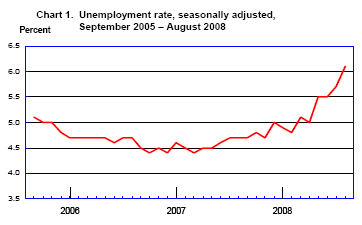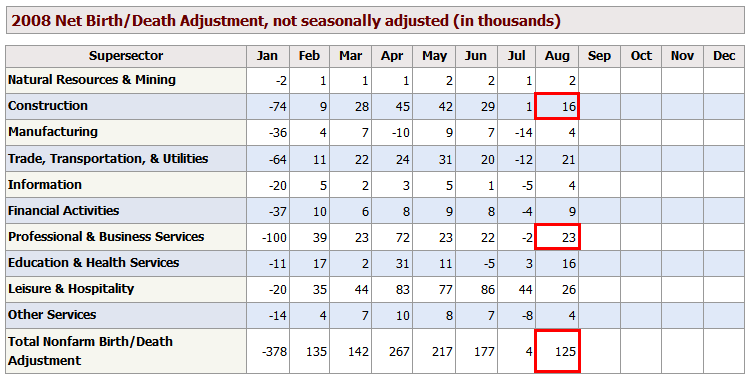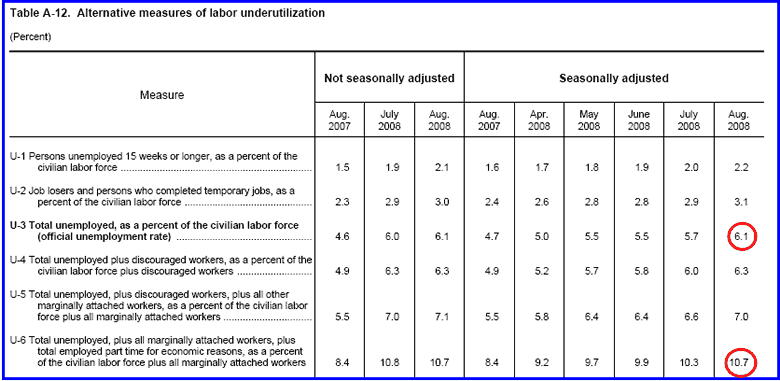US Unemployment Soars as Jobs Decline for 8th Consecutive Month
Economics / US Economy Sep 05, 2008 - 02:12 PM GMTBy: Mike_Shedlock
 Before taking a look at the monthly jobs data, let's take a look at weekly claims. The US Department of Labor is reporting Initial Unemployment Insurance Claims continue to rise.
Before taking a look at the monthly jobs data, let's take a look at weekly claims. The US Department of Labor is reporting Initial Unemployment Insurance Claims continue to rise.
Seasonally Adjusted
In the week ending Aug. 30, the advance figure for seasonally adjusted initial claims was 444,000, an increase of 15,000 from the previous week's revised figure of 429,000. The 4-week moving average was 438,000, a decrease of 3,250 from the previous week's revised average of 441,250.
Unadjusted
The advance number of actual initial claims under state programs, unadjusted, totaled 353,501 in the week ending Aug. 30, an increase of 8,374 from the previous week. There were 257,454 initial claims in the comparable week in 2007. 2007.
Jobs Decline 8th Consecutive Months
This morning, the Bureau of Labor Statistics (BLS) released the August Employment Report . Jobs were negative for a 8th consecutive month. My target of 6% or higher stated unemployment by the end of the year, made in December 2007 when the unemployment rate was 4.8% has already been reached. In December I also predicted a jobs disaster every month this year. So far that prediction is 8 for 8.
Here is a synopsis of the BLS report.
The unemployment rate rose from 5.7 to 6.1 percent in August, and nonfarm payroll employment continued to trend down (-84,000), the Bureau of Labor Statistics of the U.S. Department of Labor reported today. In August, employment fell in manufacturing and employment services, while mining and health care continued to add jobs. Average hourly earnings rose by 7 cents, or 0.4 percent, over the month.

Establishment Data

Highlights
- 08,000 construction jobs were lost
- 61,000 manufacturing jobs were lost
- 20,000 retail trade jobs were lost
- 27,000 service providing jobs were lost
- 53,000 professional and business services jobs were lost
- 55,000 education and health services jobs were added
- 4,000 leisure and hospitality jobs were lost
- 17,000 government jobs were added
These are clearly recession totals.
Birth/Death Model In Deep Outer Space Once Again
This was a very weak jobs report. And once again the Birth/Death Model assumptions are absurd. Last month the birth/death adjustments were back in orbit somewhere near Mars. This month they returned to deep outer space where they have been every month this year except for January and July.

Every month I say the same nearly the same thing. The only difference is the numbers change slightly. Here it is again: The BLS should be embarrassed to report this data.
Repeating what I have been saying for months now, virtually no one can possibly believe this data. The data is so bad, I doubt those at the BLS even believe it. But that is what their model says so that is what they report.
There is simply no way in a real estate crash that net new construction businesses are added. Nor are there net new professional and business services when mortgage and financial activity is collapsing. A quick check on the Mortgage Lender Implode-O-Meter shows that 280 Major US lending operations have imploded.
BLS Black Box
For those unfamiliar with the birth/death model, monthly jobs adjustments are made by the BLS based on economic assumptions about the birth and death of businesses (not individuals). Those assumptions are made according to estimates of where the BLS thinks we are in the economic cycle.
The BLS has admitted however, that their model will be wrong at economic turning points. And there is no doubt we are long past an economic turning point.
Here is the pertinent snip from the BLS on Birth/Death Methodology.
- The net birth/death model component figures are unique to each month and exhibit a seasonal pattern that can result in negative adjustments in some months. These models do not attempt to correct for any other potential error sources in the CES estimates such as sampling error or design limitations.
- Note that the net birth/death figures are not seasonally adjusted, and are applied to not seasonally adjusted monthly employment links to determine the final estimate.
- The most significant potential drawback to this or any model-based approach is that time series modeling assumes a predictable continuation of historical patterns and relationships and therefore is likely to have some difficulty producing reliable estimates at economic turning points or during periods when there are sudden changes in trend.
The important point in this mess is that both the job data and employment data are much worse than appears at first glance (and the first glance looked horrid).
Table A-12
Table A-12 is where one can find a better approximation of what the unemployment rate really is. Let's take a look

If you start counting all the people that want a job but gave up, all the people with part-time jobs that want a full-time job, etc., you get a closer picture of what the unemployment rate is. The official government number jumped to 6.1%, and U-6 (the most inclusive number) rose .4 to 10.7%. To the average Joe on the street unemployment feels more like 10.7% (if not 15%) than 6.1. Both numbers are poised to rise further. As noted earlier, my 6% target by the end of the year for the official number has been reached.
Looking ahead, I expect the service sector to continue to weaken. Mall vacancy rates are rising and a huge contraction in commercial real estate is finally started. There is no driver for jobs and states in forced cutback mode are making matters far worse.
Fore more on the problems facing states, please see Schwarzenegger Cuts Wages of 200,000 Workers and New York Governor Warns Of Economic Crisis .
Indeed, the Credit Crunch Has Reached Critical Mass and is now picking up steam. Unemployment is poised to soar still higher. The 6% number I projected back in December with unemployment then at 4.8% is in hindsight way too optimistic.
By Mike "Mish" Shedlock
http://globaleconomicanalysis.blogspot.com
Click Here To Scroll Thru My Recent Post List
Mike Shedlock / Mish is a registered investment advisor representative for SitkaPacific Capital Management . Sitka Pacific is an asset management firm whose goal is strong performance and low volatility, regardless of market direction.
Visit Sitka Pacific's Account Management Page to learn more about wealth management and capital preservation strategies of Sitka Pacific.
I do weekly podcasts every Thursday on HoweStreet and a brief 7 minute segment on Saturday on CKNW AM 980 in Vancouver.
When not writing about stocks or the economy I spends a great deal of time on photography and in the garden. I have over 80 magazine and book cover credits. Some of my Wisconsin and gardening images can be seen at MichaelShedlock.com .
© 2008 Mike Shedlock, All Rights Reserved
Mike Shedlock Archive |
© 2005-2022 http://www.MarketOracle.co.uk - The Market Oracle is a FREE Daily Financial Markets Analysis & Forecasting online publication.



